Let me tell you something about Kawasaki KLX250 press launches. While they sprinkle in a bit of street riding, they focus on hard core off-roading. This was true when we attended the press launch for the 2009 KLX250S. It was also true last week when we rode the 2018 KLX250 for the first time here in Southern California.
Before we tell you about our riding impressions, let’s talk about what has changed for 2018. The KLX250 now has fuel injection … and “new bold designs.” That’s it, but the fuel injection makes a big difference, as we will discuss below.
The rest of the KLX250 carries over from the redesign of the model back in 2009, and includes a 249cc DOHC single-cylinder engine with a modern, flat-top piston design, and relatively high compression at 11.0:1.
The frame is a box tubular steel design (that is quite slim) connected to an aluminum D-section swingarm. Long travel suspension includes a 43mm KYB fork (with 16-steps of damping adjustment), together with a single rear shock adjustable for compression, rebound and spring preload. Pretty high suspension specs for a 250cc dual sport.
For 2018, the KLX250 is available in two color schemes, including Lime Green and Matrix Camo Gray. MSRP for the Lime Green model is $5,349, while the Camo model is $200 more at $5,549.
We were impressed back in 2009, and the new, fuel injected KLX250 also impressed us after a lengthy, technical, rock strewn trail ride last Thursday beginning in Orange County and ending in Riverside County, California. For a street legal 250 single, the new KLX250 makes excellent, tractable power.
It has been a long time since we have ridden the older model, but the new fuel injection system seems to have improved throttle response off idle and through the mid-range. Throttle response seems a bit more immediate, as well, without ever feeling jerky.
Quite predictably, gathering a group of experienced journalists and placing them on a small displacement machine, such as a KLX250, resulted in impromptu drag races, and a general flogging of the engine, which was frequently revved close to redline. This engine has proven to be quite reliable, and the mere addition of fuel injection this year won’t change that.
Perhaps most impressive is the off-road handling of the KLX250. At roughly 200 pounds, our test rider pushed this little bike quite hard, slamming into square-edged bumps and rocks … to the point that the tires, both front and rear, were occasionally compressed to the rim. The suspension remained composed, and controlled, however.
The KLX250 offers excellent suspension, both front and rear. Leaving the bike on the settings we began the day with, the fork and shock soaked up street bumps and undulations with a controlled, yet plush feel, while still offering enough spring and damping resistance to ride the bike hard over extremely rough, off-road terrain (even mixing in some jumps).
The ergonomics are excellent — with a relatively standard dirt bike rider triangle, coupled with a very narrow mid-section between the rider’s legs. The ergonomics were just about perfect for off-road riding, allowing the rider to move fore and aft to easily shift weight.
The seat offers an excellent compromise between road comfort, and off-road functionality. Many dual sport seats are too narrow and hard to be comfortable on longer road trips, or too soft to properly support the rider during aggressive off-road riding. We were really impressed with the seat comfort of the KLX. It is wide enough to provide good comfort on the street, and firm enough (but not hard) to provide good support while slamming into off-road obstacles.
The seat height is also reasonable for a dual sport that offers such generous ground clearance. The claimed seat height is 35.0″, but the extremely narrow mid-section helps shorter riders get their feet to the pavement (or dirt). As you swing your leg over the bike, you need to clear the small pouch attached to the rear fender, which holds a tool kit, and also has room for your wallet and cell phone.
Together with that tool kit and a full tank of gas, Kawasaki claims a very low curb weight of 304 pounds for the KLX250, placing dry weight well below 300 pounds. The 2.0 gallon fuel tank should offer decent range given the expected fuel economy from the relatively small engine, which Kawasaki claims is improved this year due to the addition of fuel injection. We will test fuel economy when we get our hands on a longer-term test unit.
The disc brakes (both front and rear) offer good power and modulation, which is particularly important in the dirt. We had good brake control on slippery surfaces off-road.
The six-speed transmission shifted positively, even when shifting without the clutch off-road. The spread of gearing is good, with a low first gear for tackling tight off-road circumstances, and a sixth gear tall enough to allow comfortable highway cruising — with an indicated top speed just north of 80 mph.
As you should be able to tell from the pictures, we rode the new KLX250 hard and came away impressed. Starting at $5,349, it offers good value and versatility. We have asked Kawasaki for a test unit to do a full Ride Review, so stay tuned. In the meantime, take a look at Kawasaki’s web site for additional details and specifications.
See more of MD’s great photography:
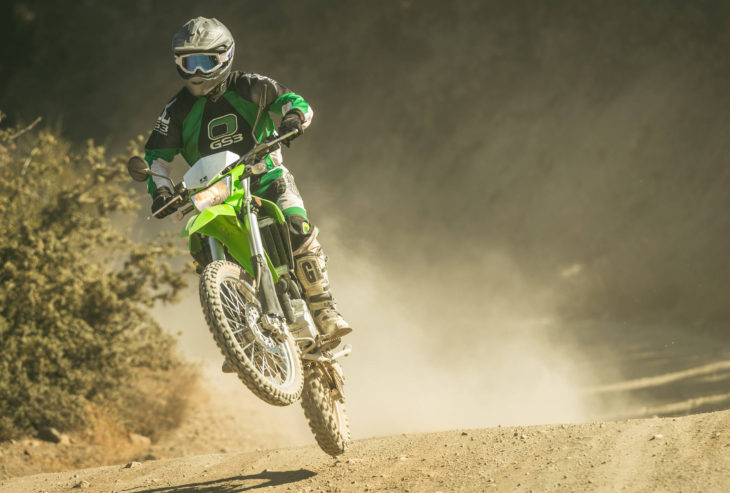
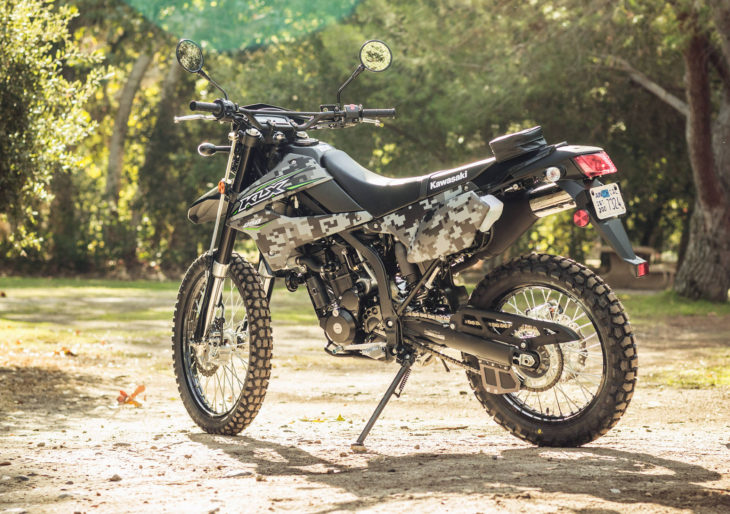
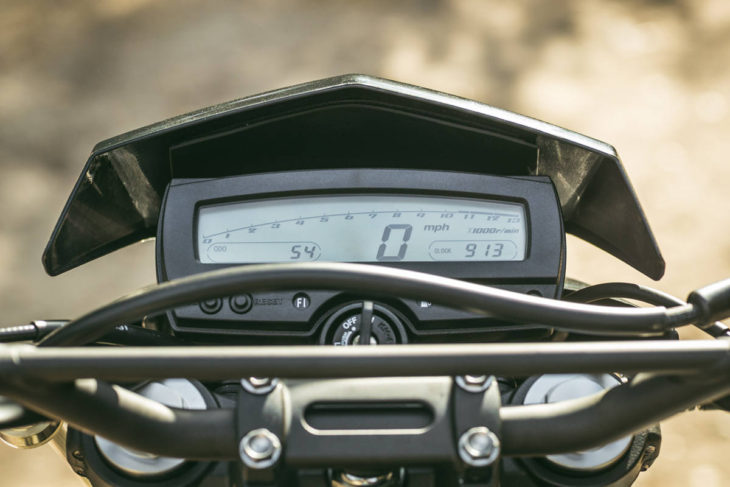
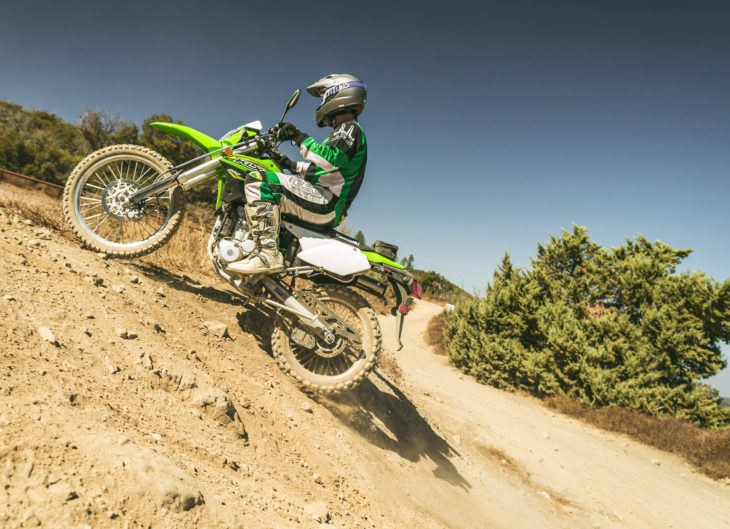
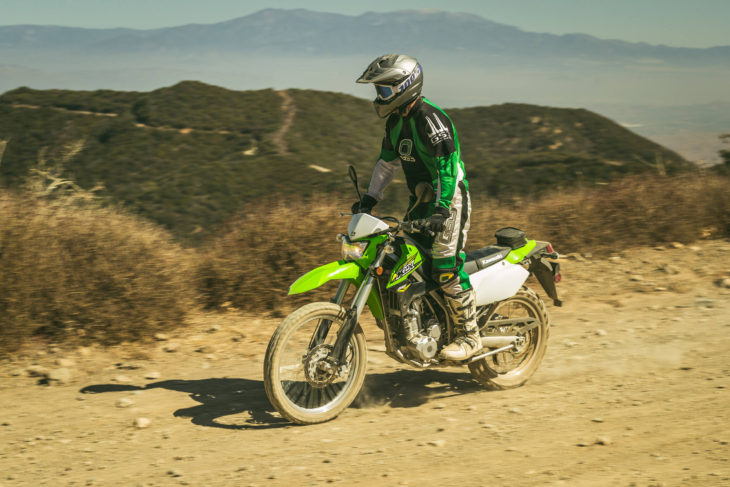
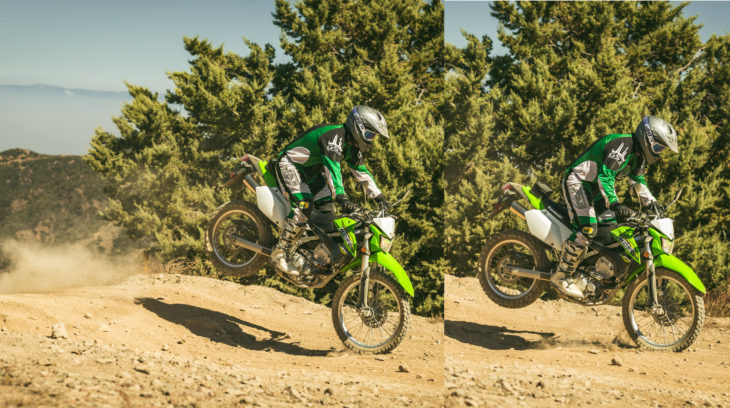
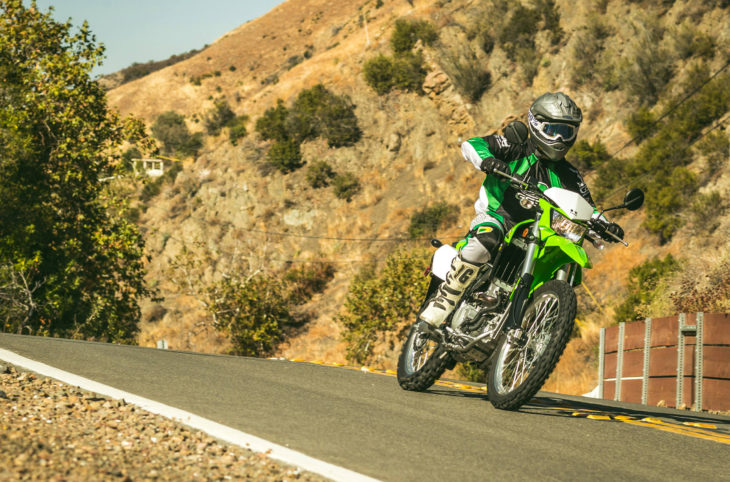






I had an 09 KLX250sf. It was fun. It just felt like it worked too hard above 60mph. Once I factored the cost of more displacement, carb, pipe, more fuel capacity, and the cost of converting wheels, it made more sense to just get a different bike.
Crank is the same as the 300’s. I have a 2014 cvk carbed model. The 292cc KLX 300 cylinder bolts right on. Hopefully bolt pattern on the new FI model is same as mine. If so, KLX 300 cylinder is $470 and piston and rings are about $90, all you need. Kustom Kraft takes a 300 cylinder, bores it to 331cc and replates it. B&B Restoration will bore your 250 cylinder and slap in an iron liner for 351cc’s. Aussie’s have had success with the 331 kit and re-mapping the FI.
This seems like a way better choice for an adventure bike than the gross tonnage on wheels 1000 cc’s-and-up-bikes that are usually selected. Just to know you won’t have a problem muscling the bike around on tight trails – especially if you drop it – would be liberating.
Damn, that Camo puppy looks sweet!
Where? I couldn’t see it.
Another plus, is the KLX300 piston and cylinder and crank should fit in this bike, not sure why they don’t just offer it this way, since they already have the parts…. making it a “KLX300 Dual Sport” would make it about the Perfect small Dual Sport bike… IMHO
I suppose the 250cc target relates to insurance and other fees, which likely jump considerably around 300cc.
For the total cost to upgrade to 300cc, are there not better value options? What is estimated cost for new parts you list above?
Is the 250cc FI head appropriate for the 300cc motor? I certainly prefer FI over a funky mechanical device from the stone age.
Please, please, stop tempting me!
Thats a good point. Will the stuff actually still fit due to the fuel injection, and what does it cost. Labor cost to put in a new crank is not that low. I did not know the 300 had a new crank, I assumed it was just the cylinder, like a big bore kit. Still, it is nice to have a 300 option from the factory if it will work, for those who want to spend the money.
Exactly, it would be an expensive upgrade…but since Kawasaki already make the parts, if they built it into a KLX300 from the factory, it would cost no more to build than the 250 does…I know in Europe, they have many requirements that make it more “World Friendly” to keep it a 250, but here in the states, a 300 would sell better for sure!
My 1999 KLX300 was excellent. I’d save money and just get another. Admittedly, mine was quite worked over and dyno’ at 36hp to the rear wheel. The Mikuni flat slide carb was extremely smooth and never had any problems. I guess the fuel injection is necessary now so they can tune it extra lean and still run halfway decent.
I just want to know where this trail is that leads from OC to Riverside.
To travel from Orange County to Riverside County (as the article mentions) one can ride Silverado Canyon to Main Divide and then take your pick of trail down into Riverside County. It is great riding.
Thank you
It’s shame, that all producers sticks now to 250cc dual sports only. 350-400 ccm are virtualy the same weight and service intervals, but lot more power, torque and fun- especially for heavier riders. People who remember DR 350 and DR-Z 400 knows, what I’m talking about.
I wonder why we can’t get this level of sophistication in the 600cc class. The Honda and Kawasaki 600s are older than Ramesses’ tinkler.
I like it. My last dual sport was an 89klr 250. Sold about 5 years ago. Wanted another. Was thing Honda 250. Gotta see them both.
Wonder why it weighs about 28# more than my old WR250R?
Yamaha claimed a wet weight of 295 lbs for the WR250R. Not a huge difference.
I checked, you’re right, as usual Jeremy.
I am definitely losing RAM…Don’t know where I got 276#.
..which makes one wonder why the aluminum framed, $1,150 more expensive WR250R is so heavy?
It’s amazing how well the styling has held up on the KLX. It is a beautiful bike. I had a 2009 and it made a great commuter. I sold it as I could not find any good off road areas near home. Fuel injection should help the hard starting in cold weather which was my biggest complaint with the bike. It would also be nice to have a place to store the owners manual other than the pouch on the back of the bike:) It also could have used a touch more power on the freeway. It was OK for a few miles but not for much more than that. Really though for the price you cannot go wrong with one of these. I am interested to see if it makes a couple more HP now with the FI which really would make it a great bike. Did I mention it’s the prettiest bike in it’s segment? Kawasaki knows styling.
Versys 300 shootout!
hm, even tho i dislike standard spokes (too much trouble to keep clean), and i don’t ride off-road except accidentally, the glowing report rouses my interest. no long distances for me; around town scooting and maybe an hour or two on the country roads.
How much horsepower do you give up compared to an 250 off-road enduro type machine? How much longer are the maintenance intervals?
A lot and a lot.
These 250 street legal machines spit out low 20 hp ratings at the wheel and have 3750-4000 mile intervals. A 250 enduro is good for 30+ hp but needs attention every 500-1000 miles
Something like the KTM 250 EXC-F will have 70% more power, 1000% more maintenance frequency (oil changes, valve adjustments, etc.), and cost nearly twice as much to acquire. The piston, connecting rod, cylinder, and head are all considered consumable wear parts, too.
When you see it under that light, it’s impressive how reliable are 600cc+ racing engines.
Probably you’ll have to jump to near-gp levels of performance to run under those maintenance requirements.
It is impressive how reliable and low maintenance the 600s are. Though to be fair, your typical 600 spends probably 98% of its running time in very low-stress conditions. You could pamper a 250 EXCF and maybe double your maintenance intervals. Keep it out of the dirt and extend them even further. Still, it is effectively a race ready engine. It’s gonna cost you no matter how nice you are to it.
This is the bike I have been looking for.
^ This is the bike a lot of people have been looking for.
This might be the bike I am looking for. Even though I really think a 300 would suit me way better. Somewhat of a disappointment there. I won’t put a loud exhaust on it to gain power and throttle response because a quiet ride is just so much more fun to me now. Previous post mentioned the DRZ350, and I also remember that was popular back in its day. Back then they were even more stuck in the standard engines sizes so nobody else followed. Other street bikes went a little higher than 250 so it seems like that is the trend today. I have heard in some countries the 250 has different rules so it might have some advantages there. I guess that’s yet another example of government getting in the way and messing stuff up.